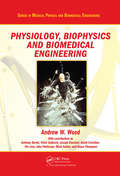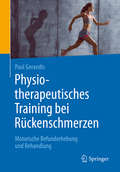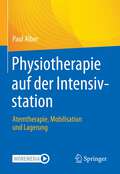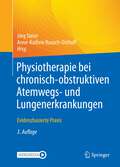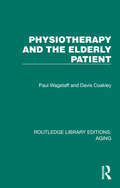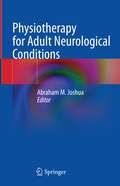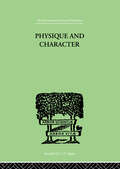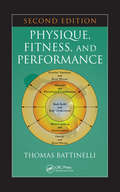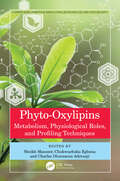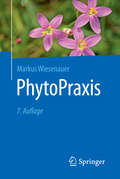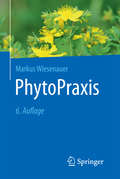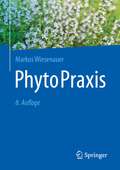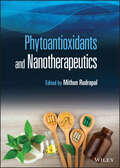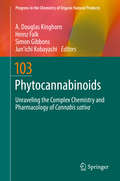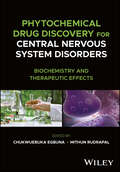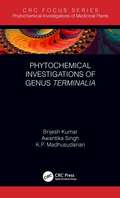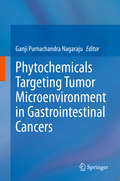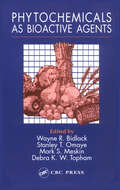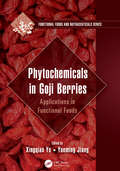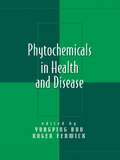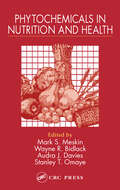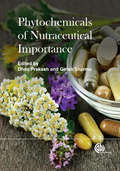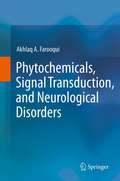- Table View
- List View
Physiology, Biophysics, and Biomedical Engineering (Series in Medical Physics and Biomedical Engineering)
by Andrew W. WoodPhysiology, Biophysics and Biomedical Engineering provides a multidisciplinary understanding of biological phenomena and the instrumentation for monitoring these phenomena. It covers the physical phenomena of electricity, pressure, and flow along with the adaptation of the physics of the phenomena to the special conditions and constraints of biolog
Physiology, Psychoacoustics and Cognition in Normal and Impaired Hearing (Advances in Experimental Medicine and Biology #894)
by Pim Dijk Deniz Başkent Etienne Gaudrain Emile Kleine Anita Wagner Cris LantingThe International Symposium on Hearing is a prestigious,triennial gathering where world-class scientists present and discuss the mostrecent advances in the field of human and animal hearing research. The 2015edition will particularly focus on integrative approaches linkingphysiological, psychophysical and cognitive aspects of normal and impairedhearing. Like previous editions, the proceedings will contain about 50 chaptersranging from basic to applied research, and of interest to neuroscientists,psychologists, audiologists, engineers, otolaryngologists, and artificialintelligence researchers.
Physiotherapeutisches Training bei Rückenschmerzen: Motorische Befunderhebung und Behandlung
by Paul GeraedtsPhysiotherapeuten, Sportwissenschaftler und Reha-Trainer finden in diesem Buch eine völlig neue Sichtweise auf die Entstehung von Rückenschmerzen und deren Konsequenzen für die Trainingstherapie. Der erfahrene Autor beleuchtet die Probleme der Diagnostik von Rückenschmerzen, eröffnet eine neue Sichtweise auf biomechanischer Ebene und leitet daraus sinnvolle Maßnahmen für das medizinische Training ab. Besonders Schüler und Berufseinsteiger finden hier leicht verständliche Informationen für eine ganzheitliche Herangehensweise bei Rückenschmerzpatienten. Erfahren Sie, wie sich Funktionseinschränkungen der peripheren Gelenke auf Rückenschmerzen auswirken und die Bedeutsamkeit der medizinischen Trainingstherapie für eine erfolgreiche Behandlung.
Physiotherapie auf der Intensivstation: Atemtherapie, Mobilisation und Lagerung
by Paul AlberDieses Praxisbuch liefert Physiotherapeuten wesentliche Grundlagen für die Arbeit mit Intensivpatienten. Was beinhaltet der atemtherapeutische Befund bei sedierten Patienten? Wie sichere ich den Tubus während der Mobilisation der Halsfaszien? Welche Technik eignet sich für die Behandlung eines kranialisierten Diaphragmas? Hier finden Sie die Antworten!Aus dem Inhalt:• Strukturen einer Intensivstation inkl. Patientenzentrierung, Dokumentation und Hygiene• Mentale Funktionen und Erhebungsinstrumente• Physiologie und Pathologie von Atmung, Formen der Beatmung, Weaning und Atemtherapie• Sensomotorik, normale Bewegung, Lagerung und MobilisationPlus: Befundbögen zum Download! Mit beeindruckenden Erfahrungsberichten eines ehemaligen Patienten und realen Bildern von der Intensivstation.
Physiotherapie bei chronisch-obstruktiven Atemwegs- und Lungenerkrankungen: Evidenzbasierte Praxis
by Jörg Steier Anne-Kathrin Rausch-OsthoffDieses Praxisbuch liefert Physiotherapeuten alle wesentlichen Grundlagen zur Behandlung von chronisch-obstruktiven Lungenerkrankungen: • Physiologische Grundlagen des Atembewegungsapparates, Ventilation, Perfusion, Reinigungsmechanismen u.v.m.• Pathologie, chronische Überblähung und Auswirkungen auf andere Organe• Assessments und Befunde bspw. zu Atemmuster, respiratorischer Muskelkraft und Lebensqualität• Atemtherapie auf der Intensivstation, in der pulmonalen Rehabilitation und der Pädiatrie Neu in der 3. Auflage: Das Standardwerk der ehemaligen Herausgeber Prof. Dr. Arnoldus J. R. van Gestel und Prof. Dr. Helmut Teschler komplett überarbeitet und aktualisiert. Inklusive Videos mit der SpringerNature MoreMedia-App!
Physiotherapy and the Elderly Patient (Routledge Library Editions: Aging)
by Davis Coakley Paul WagstaffOriginally published in 1988, the purpose of this book was to introduce the student and practicing physiotherapist to the multi-faceted components of the care and treatment of elderly patients and to present a problem-orientated approach to physiotherapy, assessment and management. Care of the elderly demands a dynamic and responsible approach and it was hoped that this book would improve therapy skills. The authors’ principle aim was to describe appropriate physiotherapy practice together with the pathology and medicine of old age. There is also consideration of social and psychological issues and working with the elderly people in the community as well as in hospital.
Physiotherapy for Adult Neurological Conditions
by Abraham M. JoshuaThis is a comprehensive book on physiotherapy for adult neurological disorders with chapters describing physiotherapy assessment and management for those adult patients in the acute care and rehabilitation units of hospitals or centers. Each chapter additionally provides brief introduction, historical background, etiology, pathophysiology, clinical manifestations, medical and surgical management. The aim is to help build a theoretical foundation on which principles of management are laid, and to improve and update the readers' clinical and therapeutic skills. Improving the overall care and management of patients suffering from adult neurological conditions such as stroke, Parkinson's disease, traumatic brain injury, and multiple sclerosis, is the key objective. Supported with ample practical contents (exercise training and therapeutic strategies) and pictures it prepares the readers to effectively manage patients with neurological conditions. The contents of this book will serve as a guide and source of knowledge of both contemporary and advanced treatment techniques for undergraduate and post-graduate students and therapists practicing worldwide in adult neurological physiotherapy.
Physique and Character: an investigation of the nature of constitution and of the Theory
by Kretschmer, ErnstFirst Published in 1999. Routledge is an imprint of Taylor & Francis, an informa company.
Physique, Fitness, and Performance (Exercise Physiology)
by Thomas BattinelliTotally revised and updated, this second edition of the well-received Physique, Fitness, and Performance retains the unique integrated approach of its predecessor, examining the relationship of structure to function in human performance. Far surpassing the limited focus of standard exercise and fitness books, it combines the morphological study of
Phyto-Oxylipins: Metabolism, Physiological Roles, and Profiling Techniques (Current Developments in Agricultural Biotechnology and Food Security)
by Chukwuebuka Egbuna Charles Oluwaseun Adetunji Sheikh MansoorOxylipins are an important class of signaling molecules in plants, which play an important role in plant defence and innate immunity. Oxylipins have critical roles in plant growth and plant responses to physical damage caused by herbivores, insects, and pathogenic microbes. Over the last decade, our understanding of oxylipin production, metabolism, and function, particularly jasmonates, has advanced considerably. Jasmonates have provided further mechanistic insights into enzyme function and signalling cascades. Other oxylipins, such as hydroxy fatty acids, have recently been shown to exhibit individual signaling features and crosstalk with other phytohormones. There is scant literature on plant oxylipins and their relevance to our understanding and therefore, understanding oxylipin production, metabolism, and function is pivotal. As a result, researchers, students, professors, and other book readers will have a thorough understanding of plant oxylipin biosynthesis, structure, and function, assisting in the improvement of plant science. Plant oxylipins: metabolism, physiological roles, and profiling techniques address the mechanism, metabolism, and roles of oxylipins in plant resistance to various biotic and abiotic stimuli in detail. This book covers fundamental ideas in oxylipin production, metabolism, structural biochemistry, and signaling pathways. It also discusses cutting-edge methodologies for oxylipin metabolic profiling, with an emphasis on computing applications. This book is an excellent resource for plant scientists, plant biochemists, biotechnologists, botanists, phytochemists, toxicologists, chemical ecologists, taxonomists, and other scholars in those subjects. The book is written by a global team of professionals. Features Presents concrete and extensive information about a basic and applied aspect of plant oxylipins as well as expanded coverage of signaling mechanisms. Highlights the fundamental concepts of the biosynthesis, metabolism, structural biochemistry, and signaling pathway of oxylipins. Details the state-of-the-art methods and techniques in metabolic profiling of oxylipins in plants. Presents insights on computational applications in the evaluation and study of oxylipins in plants.
PhytoPraxis
by Markus Wiesenauer Annette KerckhoffJeder praktisch tätige Arzt benötigt ein handliches Nachschlagewerk über Phytotherapeutika, das ihm schnell und kompetent Auskunft gibt. Ausgehend von den häufigsten Symptomen stellt dieses Taschenbuch den wirksamen Einsatz von Phytoparmaka dar. Das praxiserprobte Nachschlagewerk in seiner 7. Auflage ermöglicht eine hochwirksame, risikoarme und kostengünstige Behandlung, die zugleich eine hohe Patientzufriedenheit sicherstellt: für alle Allgemeinmediziner, Internisten, Gynäkologen und Pädiater, die Phytopharmaka gezielt in der Therapie einsetzen möchten.
PhytoPraxis
by Markus WiesenauerJeder praktisch tätige Arzt benötigt ein handliches Nachschlagewerk über Phytotherapeutika, das ihm schnell und kompetent Auskunft gibt. Ausgehend von den häufigsten Symptomen stellt es den wirksamen Einsatz von Phytoparmaka dar: · Indikationsbezogen strukturiert nach Symptomen und Krankheitsbildern · Wirksamkeitsbelegte Arzneidrogen mit Präparatebeispielen und Dosierung · Praxisbewährte Auswahl an Phytopharmaka unter Berücksichtigung von Leitlinien und Cochrane Reviews · Plus: Hinweise zur Verordnungsfähigkeit Zum Nachschlagen · Umfassendes Stichwortverzeichnis · Ausführliches Präparateverzeichnis · Individuelle Teemischungen · Weiterführende Literatur, Adressen und Websites Neu in der 6. Auflage: Das Kapitel zu Kindern wurde vollständig aktualisiert und erweitert. Das praxiserprobte Nachschlagewerk in seiner 6. Auflage ermöglicht eine hochwirksame, risikoarme und kostengünstige Behandlung, die zugleich eine hohe Patientzufriedenheit sicherstellt: für alle Allgemeinmediziner, Internisten, Gynäkologen und Pädiater, die Phytopharmaka gezielt in der Therapie einsetzen möchten.
PhytoPraxis
by Markus WiesenauerIn der Allgemeinmedizin wird häufig ein handliches Nachschlagewerk über Phytotherapeutika benötigt, das schnell und kompetent Auskunft gibt. Ausgehend von den häufigsten Symptomen stellt dieses Taschenbuch den wirksamen Einsatz von Phytoparmaka dar. Das praxiserprobte Nachschlagewerk in seiner 8. Auflage ermöglicht eine hochwirksame, risikoarme und kostengünstige Behandlung, die zugleich eine hohe Patientenzufriedenheit sicherstellt: Für alle Tätigen in der Allgemeinmedizin, Inneren Medizin, Gynäkologie und Pädiatrie, die Phytopharmaka gezielt in der Therapie einsetzen möchten. Plus: Hinweise zur Verordnungsfähigkeit und Qualitätskriterien Neu in der komplett aktualisierten 8. Auflage: Allergische Rhinitis, Post- und Long-Covid, Darm-Mikrobiom, Phytopharmaka mit Wirkung auf den Stoffwechsel
Phytoantioxidants and Nanotherapeutics
by Mithun RudrapalPhytoantioxidants and Nanotherapeutics Discover the medicinal importance of antioxidant herbal medicines, phytochemicals, and nanodelivery systems for a wide range of diseases Phytomedicine has been—and continues to be—central to many cultures and societies due to its low toxicity, low cost, accessibility, and efficacy in treating difficult diseases. In fact, many plant-derived bioactive natural products serve as potential sources of drug leads or therapeutic agents in the treatment of a wide range of human diseases. When combined with nanotechnology, phytomedicine has the potential to affect and impact a tissue-specific site, which can reduce drug dosage and side effects while improving activity. Phytoantioxidants and Nanotherapeutics offers a comprehensive look at the significant role that phytomedicine-derived antioxidants play on the field of medicine, particularly when combined with the nanotechnology-derived drug delivery systems. The book thoroughly covers the herbs, plant extracts, and other dietary elements that may be used as sources of natural antioxidants and similarly highlights the use of phytomedicine- derived bioactive compounds including plant polyphenols and flavonoids to reducing the impact of oxidative stress induced human diseases. The text also demonstrates the biochemical and therapeutic targets of nanodrugs and discusses nanostructure toxicity, while emphasizing the challenges and regulatory issues involved with nanophytotherapeutics. Phytoantioxidants and Nanotherapeutics readers will also find: A helpful bridge between the cutting-edge field of nanotechnology delivery and phytotherapeutics The potential role of bioactive phytochemicals, particularly polyphenolic compounds and flavonoids, in oxidative stress-induced diseases Description of the latest developments on nanotherapeutics of phytoantioxidants for the treatment of certain chronic human diseases, such as cancer, inflammations, diabetes, viral, bacterial and parasitic infections, nervous system disorders, cardiovascular disorders, and neurological diseases. Phytoantioxidants and Nanotherapeutics is a useful reference for drug manufacturers and drug developers, formulation scientists, biomedical scientists, medicinal chemists, phytochemists, healthcare providers, and academics and researchers.
Phytocannabinoids
by A. Douglas Kinghorn Heinz Falk Simon Gibbons Jun’ichi KobayashiThe book presents the current state of the art on phytocannnabinoid chemistry and pharmacology and will be of much use to those wishing to understand the current landscape of the exciting and intriguing phytocannabinoid science. The focus is on natural product cannabinoids which have been demonstrated to act at specific receptor targets in the CNS.
Phytochemical Drug Discovery for Central Nervous System Disorders: Biochemistry and Therapeutic Effects
by Chukwuebuka Egbuna Mithun RudrapalPHYTOCHEMICAL DRUG DISCOVERY FOR CENTRAL NERVOUS SYSTEM DISORDERS Understand herbal and plant-based treatments for chronic disorders with this groundbreaking work Due in part to the aging of the global population, disorders of the central nervous system have become an increasingly grave public health concern in recent years. Demand for pharmaceutical treatments has been correspondingly high, but there are many barriers to the successful development of effective synthetic drugs. Phytomedicines, or plant-based and herbal medicines, have proven to be an effective alternative, boasting lower toxicity and cost and higher efficacy, and one that demands greater research and broader-based practitioner knowledge. Phytochemical Drug Discovery for Central Nervous System Disorders meets this demand with a timely, clearly-structured guide. It thorough coverage presents a wide range of phytochemicals with potential as candidates for drug discovery, describing their sources, properties, and therapeutic efficacy. The result is a vital contribution to the ongoing fight against central nervous system (CNS) disorders. Phytochemical Drug Discovery for Central Nervous System Disorders readers will also find: Detailed treatment of CNS-active plant products, neuroprotective chemicals, plant-based nutraceutical products, and more Up-to-date information on FDA-approved drugs and existing plant-based products used to treat CNS disorders An authorial team featuring experts from across the globe Phytochemical Drug Discovery for Central Nervous System Disorders is essential for drug discovery scientists, drug developers, medicinal chemists, biochemists, and any researchers and professionals in the health care or pharmaceutical industries.
Phytochemical Investigations of Genus Terminalia (Phytochemical Investigations of Medicinal Plants)
by Brijesh Kumar K. P. Madhusudanan Awantika SinghGenus Terminalia is known to be a rich source of secondary metabolites, mainly polypohenols and triterpenoids. About 39 species have been phytochemically studied leading to the identification of 368 compounds. This work involves the use of hyphenated mass spectrometric methods such as HPLC-ESI-QTOF-MS/MS and UPLC-ESI-QqQLIT-MS/MS for qualitative and quantitative analysis of major bioactive constituents in selected medicinal plants without isolation. It also describes the methods of mass fingerprinting and their use to investigate the plant species variations with the help of statistical software’s (PCA). Markers were identified for quality control and authentications.
Phytochemicals Targeting Tumor Microenvironment in Gastrointestinal Cancers
by Ganji Purnachandra NagarajuGastrointestinal (GI) malignancies account for a large portion of cancers worldwide. Although incidence of esophageal, gastric, and colorectal cancers has decreased in recent years, pancreatic and liver cancer have increased. The mainstay of GI cancer therapy is chemoradiation and surgery. Despite significant medical advancements, diagnosis and therapy for GI cancers remain challenging due to tumor cell resistance to chemoradiotherapy. The tumor’s increased cell signalling due to excessive transcription factor activation and increased stellate cell activity leads to collagen deposition formation of a dense stroma around the tumor, which prevents drugs from reaching the malignant cells. This leads to tumor chemoresistance.To circumvent these difficulties, drug therapy targeting the tumor’s specific microenvironment and the additive anticancer effect of phytochemicals can allow for more effective treatment. This volume will be the first on the market on the topic of phytochemicals and their effect on the tumor microenvironment (TME). TME is an emerging area of research and the book will be a welcome introductory addition to the field.
Phytochemicals as Bioactive Agents
by Mark S. Meskin Wayne R. Bidlack Stanley T. Omaye Debra K. W. TophamPhytochemicals as Bioactive Agents focuses on the mechanisms of action of phytochemicals identified as displaying bioactivity in the prevention of cancer, heart disease and other diseases and the prospects for developing functional foods containing these bioactive compounds. Internationally recognized experts present the latest research findings on the antimutagenic and anticarcinogenic effects of tea and tea constituents; chemoprevention provided by plants in the family Cruciferae and genus Allium; anticarcinogenic effects of carotenoids and curcumins; the chemistry and application of alfalfa saponins; the bioactive components of rice bran and rice oil; the effects of garlic on lowering serum cholesterol; and using phytochemicals to optimize gastrointestinal tract health and function.
Phytochemicals in Goji Berries: Applications in Functional Foods (Functional Foods and Nutraceuticals)
by Xingqian Ye and Yueming JiangGoji berries (Lycium barbarum), which are widely distributed in Northwestern China, Southeastern Europe and the Mediterranean areas, have traditionally been employed in Chinese medicine from ancient times. Goji berries, also known as wolfberry, have become increasingly popular in the Western world because of their nutritional properties, often advertised as a superfood in Europe and North America. With the development of analysis methods, various chemical constituents have been identified, including carbohydrates, carotenoids, flavonoids, betaine, cerebroside, -sitosterol, amino acids, trace elements, vitamins and other constituents. Polysaccharides have been identified as one of the major active ingredients responsible for biological activities. Phytochemicals in Goji Berries: Applications in Functional Foods, a volume in the Functional Foods and Nutraceuticals Series, provides information about the chemical, biochemical, botanic properties, bioactive components and health benefits of Goji berries. It also discusses postharvest storage technology, processing technology, and the development and utilization of Goji berry by-products in medicinal foods and functional foods, as well as addressing food safety issues. Features: Provide information on Goji fruit origin and growing conditions, distribution, and biochemical properties Discusses such medicinal properties and health benefits of Goji berries as the capacity to lower blood pressure, treat anemia, maintain cholesterol levels in the normal range and decrease risk of cardiovascular disease. Additionally, Goji berries have anti-inflammatory and anti-tumor properties, among others Includes information on traditional products, new products and innovative processing technologies This book will serve college and university students majoring in food science, nutrition, pharmaceutical science, and botanical science. It also will serve as a unique reference for food science professionals pursuing functional foods, marketing expansion, as well as nutritional dietary management. Readers will obtain sound scientific knowledge of the nutritional value and health benefits of the different Goji berry products such as juice, cake, soup, snacks, and medicinal foods. Also available in the Functional Foods and Nutraceuticals series: Korean Functional Foods: Composition, Processing and Health Benefits, edited by Kun-Young Park, Dae Young Kwon, Ki Won Lee, Sunmin Park (ISBN 978-1-4987-9965-2) Phytochemicals in Citrus: Applications in Functional Foods, edited by Xingqian Ye (ISBN 978-1-4987-4272-6) Food as Medicine: Functional Food Plants of Africa, by Maurice M. Iwu (ISBN 978-1-4987-0609-4) For a complete list of books in the series, please visit our website at https://www.crcpress.com/Functional-Foods-and-Nutraceuticals/book-series/CRCFUNFOONUT
Phytochemicals in Health and Disease (Oxidative Stress And Disease Ser. #Vol. 12)
by Yongping Bao Roger Fenwick"� well-written and the content is clearly presented. � There are plentiful figures and tables, which are effectively labeled and adequately support the content. �highly recommended for academic and special libraries. �effectively presents current research on phytochemicals in a readable manner."- E-Streams "This landmark volume shows h
Phytochemicals in Nutrition and Health
by Mark S. Meskin Wayne R. Bidlack Stanley T. Omaye Audra J. DaviesAre soy isoflavones neuroprotective? Just how different is one species of Echinacea from another? Which phytochemicals will be effective as therapeutic agents in vivo? Supported by solid scientific research, Phytochemicals in Nutrition and Health helps provide answers to these and other probing questions concerning the mechanisms of action associat
Phytochemicals of Nutraceutical Importance
by Girish Sharma Dhan PrakashNutraceuticals are bioactive phytochemicals that protect or promote health and occur at the intersection of food and pharmaceutical industries. This book will cover a wider spectrum of human health and diseases including the role of phytonutrients in the prevention and treatment. The Book includes chapters dealing with biological and clinical effect, molecular level approach, quality assurance, bioavailability and metabolism of a number phytochemicals and their role to combat different diseases.
Phytochemicals of Nutraceutical Importance
by Girish Sharma Dhan PrakashNutraceuticals are bioactive phytochemicals that protect or promote health and occur at the intersection of food and pharmaceutical industries. This book covers a wide spectrum of human health and diseases, including the role of phytonutrients in the prevention and treatment. It also reviews biological and clinical effect, molecular level approach, quality assurance, bioavailability and metabolism of a number phytochemicals, and their role to combat different diseases.
Phytochemicals, Signal Transduction, and Neurological Disorders
by Akhlaq A. FarooquiPhytochemicals Signal Transduction and Neurological Disorders Phytochemicals are heterogeneous group of bioactive compounds produced by plants, which are extensively researched by scientists for their health-promoting potentials in human diseases. Unlike vitamins and minerals, phytochemicals are not required for sustaining cell viability, but they play an important role in protecting tissues and cells from the harmful effects of oxidative stress and inflammation. Examples of phytochemicals include catechins, resveratrol, ginkgo biloba, curcumin, and sulfur compounds found in garlic. Although, the precise molecular mechanisms associated with beneficial effects of phytochemicals still remain the subject of intense investigations, but it is becoming increasingly evident that phytochemicals mediate their effects by counteracting, reducing, and repairing the damage caused by oxidative stress and neuroinflammation. In addition, phytochemicals also stimulate the synthesis of adaptive enzymes and proteins through the stimulation of a transcription factor called Nrf2 and induction of phase II detoxifying enzymes. Consumption of phytochemicals induces neurohormetic response that results in the expression of adaptive stress-resistance genes that are responsible for encoding antioxidant enzymes, protein chaperones, and neurotrophic factor (BDNF). Based on the stimulation of signal transduction network and adaptive stress-resistance genes, it is proposed that the use of phytochemicals from childhood to old age along with regular exercise is an important strategy for maintaining normal aging and delaying onset of age-related neurological disorders (stroke, Alzheimer disease, and Parkinson disease). Phytochemicals Signal Transduction and Neurological Disorders presents readers with cutting edge and comprehensive information not only on bioavailability, and mechanism of action of phytochemicals in the brain, but also provides the molecular mechanism associated with beneficial effects of phytochemicals in neurotraumatic (stroke, spinal cord trauma, and traumatic brain injury) and neurodegenerative (Alzheimers disease, Parkinson disease, Huntington disease, and amyotrophic lateral sclerosis) diseases.
